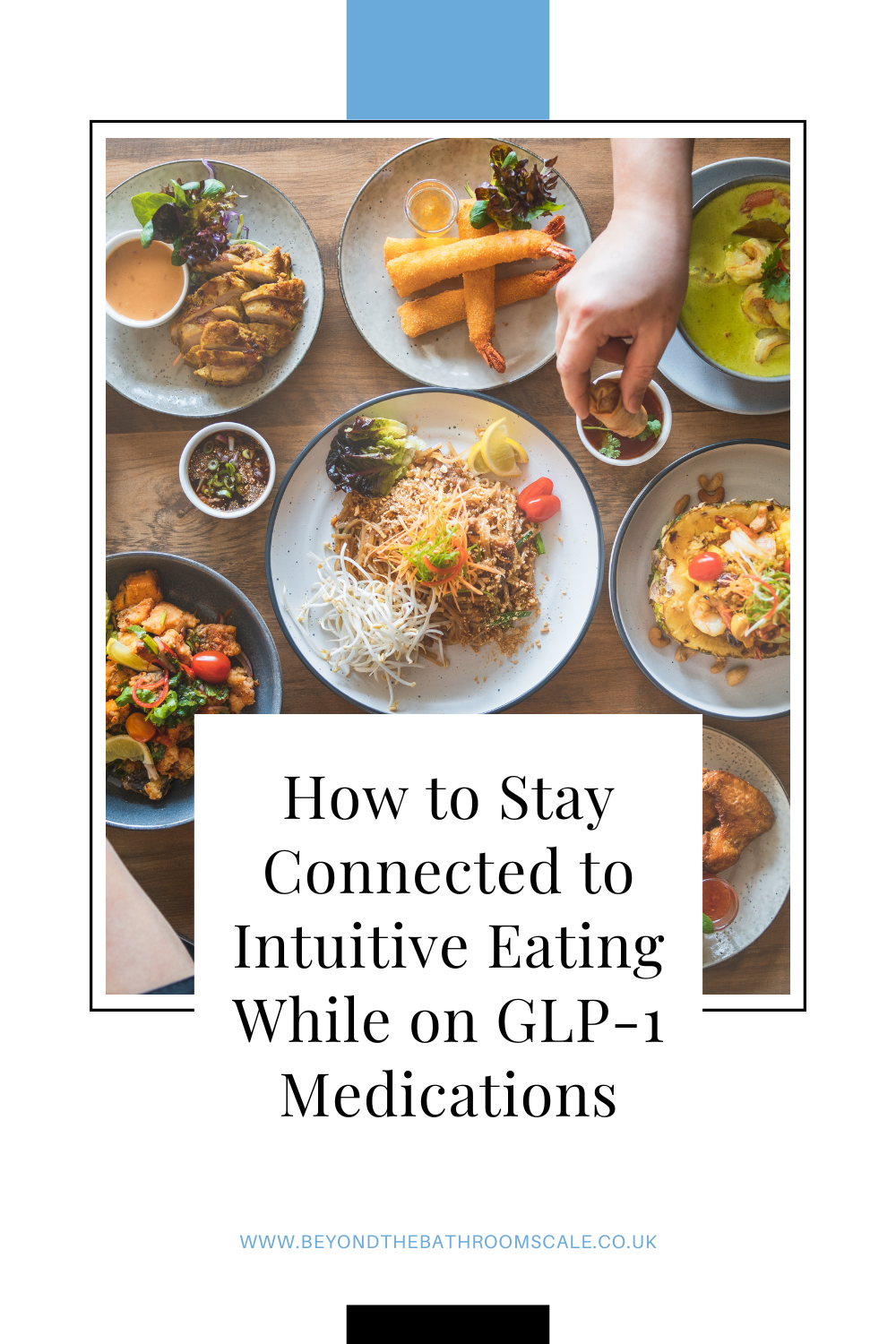How to Stay Connected to Intuitive Eating While on GLP-1s
If you’re taking a GLP-1 medication like Ozempic, Wegovy or Mounjaro, you might find yourself wondering: Can I still practise intuitive eating while on this drug?
It’s a fair (and complicated!) question. After all, GLP-1 medications reduce hunger, slow digestion, and often lead to weight loss. Intuitive eating, on the other hand, asks us to tune into hunger and fullness cues, reject the pursuit of intentional weight loss, and build trust with our bodies.
At first glance, these ideas might feel completely at odds. But I want to offer a gentler perspective - one that honours the reality of your lived experience, supports your mental health, and helps you stay grounded in the values of intuitive eating, even if your journey looks different from what you imagined.
Let’s explore how that might look in practice.
1. Redefine What Intuitive Eating Means for You Right Now
Intuitive eating isn’t a rigid set of rules, it’s a flexible, responsive framework rooted in self-trust. And like all relationships, your connection with food will shift depending on your circumstances, health needs, and emotional state.
Taking a GLP-1 doesn’t mean you’ve failed intuitive eating. It means your body is experiencing something new, and it’s okay to adapt. You can still practise:
Curiosity over control
Self-compassion over shame
Awareness over avoidance
Give yourself permission to redefine intuitive eating on your own terms, even if it doesn’t fit the “ideal” version you’ve seen online.
2. Honour Hunger—Even When It’s Subtle or Missing
GLP-1s are designed to suppress appetite, but that doesn’t mean your body no longer needs nourishment. One of the most supportive things you can do is eat anyway.
Hunger might show up differently: as brain fog, irritability, dizziness, or fatigue. Or you might not notice it at all until you’re suddenly feeling unwell. Rather than waiting for extreme cues, try gentle structure, like eating regular meals and snacks throughout the day, to support your body.
This isn’t forced eating. It’s attuned eating in a new context.
3. Stay Curious About Satisfaction
Even if you’re eating less or feeling full more quickly, you can still pay attention to what satisfies you, not just physically, but emotionally. Are you still allowing foods you enjoy? Are you giving yourself permission to experience pleasure without guilt?
Intuitive eating isn’t just about hunger and fullness—it’s also about satisfaction, variety, and freedom. Try to notice if you’re slipping into diet culture patterns (e.g. “I should choose the lowest calorie option” or “I don’t deserve dessert”) and gently challenge them.
Your body’s cues may be muted, but your preferences and needs still matter.
4. Name the Influence of Diet Culture
GLP-1 medications exist within a cultural context—one that heavily values weight loss and treats thinness as a moral good. If you’re feeling pressure to “make the most” of your medication, or fear weight regain, that’s not a personal failing—it’s the result of internalised weight stigma.
Part of intuitive eating is unlearning that stigma. Try asking:
Am I eating this way because it feels good, or because I’m afraid of gaining weight?
Would I still choose this if I trusted my body?
Who benefits from my feelings of shame about food or my body right now?
These reflections can help you stay connected to your values, even when the cultural noise is loud.
5. Use Mindfulness to Stay Present With Your Body
When physical cues are harder to access, mindfulness can help you reconnect. This might look like:
Checking in with your energy levels before and after meals
Noticing how different foods make you feel—physically and emotionally
Taking a moment to pause and breathe before eating, just to tune in
Mindfulness isn’t about control—it’s about noticing. It can create a bridge between your intentions and your bodily experience, especially when that experience is shifting.
6. Give Yourself Grace
You don’t have to get this perfect. There is no “right” way to navigate intuitive eating while on a GLP-1. If some days feel confusing or disconnected, that’s okay. You’re learning. You’re showing up. You’re honouring yourself the best way you know how.
Grace might sound like:
“It’s okay that I didn’t feel hungry today. I still deserve nourishment.”
“I’m allowed to enjoy food, even if my appetite is smaller.”
“Taking this medication doesn’t undo the work I’ve done. It just changes the context.”
You’re Still Allowed to Be Free From Food Rules
GLP-1s can change how your body functions—but they don’t have to take away your agency, your values, or your right to peace with food. You can make medical decisions and resist diet culture. You can lose weight and reject weight-based worth. You can take a medication and still listen to and honour your body in new ways.
Support for the Journey
If you’d like help navigating these changes, my GLP-1 Coaching Workbook is here to support you.
Inside, you’ll find:
✔️ Reflections and prompts to explore how your relationship with food and body is shifting
✔️ Tools for staying grounded in intuitive eating principles—adapted for GLP-1 users
✔️ Guidance to help you separate medical care from diet culture messaging
✔️ Space to process big feelings, without judgment
TL;DR Summary:
Can you practise intuitive eating while taking GLP-1 medications like Ozempic or Wegovy? Yes - but it might look different than you expect. This post explores how to stay attuned to your body, nourish yourself with compassion, and stay rooted in your values, even when appetite cues are suppressed.


